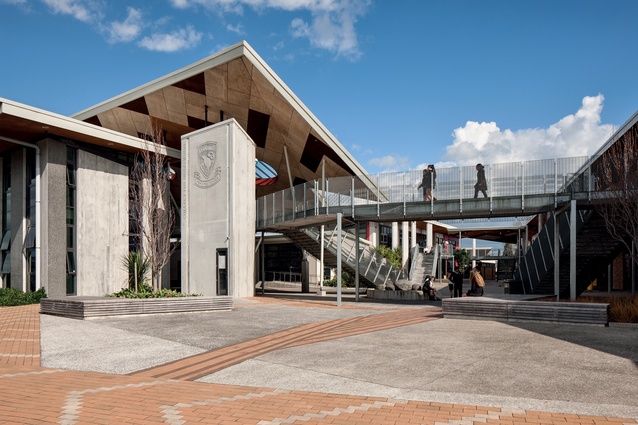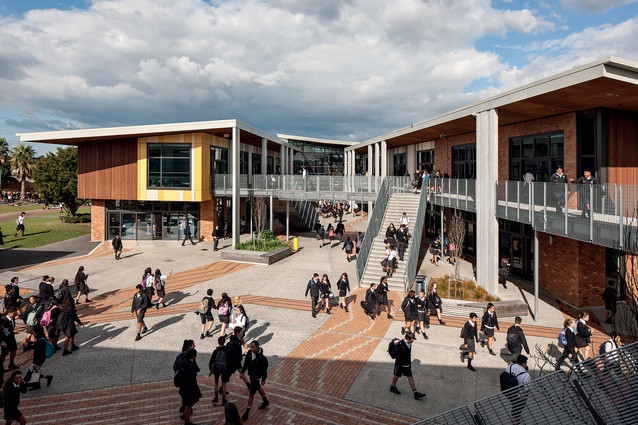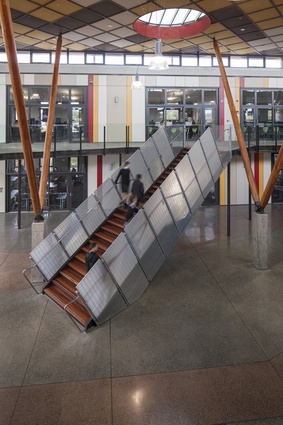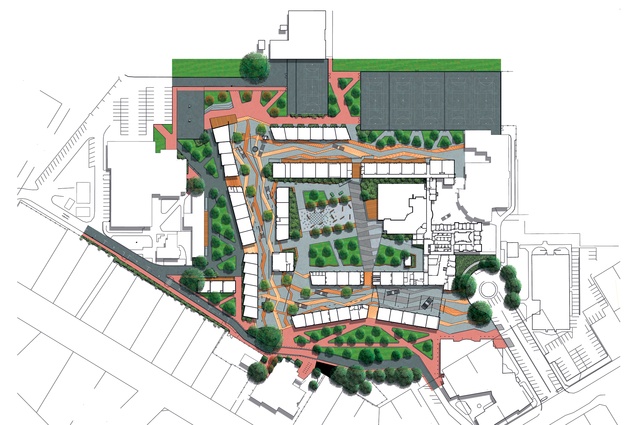Avondale College
When taking visitors to Auckland’s new towns, such as Flat Bush, Hobsonville Point and so on, I tease them by pointing out certain buildings from a distance and asking them to guess what they are. They never think they are schools, such is the nature of the new joined-up, multi-storeyed, complexes we are seeing sprouting in newly urbanised areas of the nation. Schools are a building type that has changed radically in the last decade or so, driven primarily (and refreshingly) through new pedagogical thinking rather than architects’ whims or Ministry of Education rules.

Auckland’s Avondale College is one of the largest secondary schools in the country and was built during World War II to be an American naval hospital, designed by Tibor Donner, who, later, would become Auckland City’s chief architect. Some of the structures were constructed of permanent materials for later conversion to school use. After a huge fire in 1990, rebuilding of the school saw its administration area, in particular, take on a slightly American-college-campus-style aesthetic that always seemed to me to have been lifted from the pages of the Reader’s Digest, that slightly conservative, vaguely religious monthly mail-order publication that was once to be found in nearly every middle-class household in the nation.
When I first saw Avondale’s new blocks taking shape, particularly the central atrium building with its large v-profiled, umbrella-like roof and wide entrance, it was a breath of fresh Auckland air. With its open, slightly Polynesian flavour, finally the school has something expressive of its character: a decile-4 school with a very diverse population of students, many of them having Pacific heritage.
This atrium is the entrance to the whole school and, although it has a reception area tucked away to the right, the focus is straightaway on students. It is the beginning of a series of urban street-like spaces that work their way around the school with two storeys of classrooms on either side. I love the fire-station doors that open the front completely on nice days and give a sense that the school is wide open to the community and the world. These urban streets with their series of sitting places and little precincts also treat students and staff as adults, citizens of an environment, which is quite different from the high schools of my youth where we were channelled by hall and covered way from room to room.
The contemporary school is an exercise in urban design as much as in architecture, although the urban design here is very Auckland: streets rather than squares and a bit more Westie than your private schools with their quads. Slots of space between the various blocks open up axial views across the school grounds, which aid in wayfinding and orientation, as well as offering glimpses of green spaces, playing fields and the wider landscape. And cunning little glazed projections in staff spaces allow a good amount of passive surveillance of the environment.

You may have gathered by now that I know this school reasonably well – three of my sons went there. It has always been a bit of a pull-up-your-socks-and-tuck-your-shirt-in kind of place so, somewhat conventionally, the classrooms I mentioned are indeed classrooms, not new-style learning spaces or big studios.
However, Jasmax has placed the primary structure on the outside of the colonnades and walkways with ‘soft’ infill (although highly insulated) walls to the classroom faces and sides. This provides a degree of flexibility to reconfigure the spaces in the future, allowing formation of the currently favoured long, studio-style spaces with break-out areas, quiet zones and so on.
Another large umbrella-like, v-profiled roof appears elsewhere in the school but it’s the one over the so-called atrium at the school entrance that is most meaningful. The pattern of plywood panels across the ceiling refers to the shape of godwits, kūaka in Māori, which are a little-valued but very special feature of our part of town. Due to the Manukau and Waitematā Harbours, in this narrowest neck of the country, having tide times that are quite different from one another, these birds, as well as oystercatchers, stilts and their ilk, can flit back and forth from harbour to harbour, from low tide to low tide, continuously feeding over summer.

But it’s the little kūaka, which heads off to Siberia on an annual OE (overseas experience) to the other side of the planet, that is a unique sight in this area; clouds of them can be seen on every turn of the tide flocking over the Avondale area commuting from harbour to harbour. Given that a good number of the students at Avondale are new to New Zealand, this is a particularly apt metaphor to depict on both the ceiling and in paving patterns: little creatures that leave their home harbours and take flight for the wide open spaces and the world.
There is another lovely little metaphor in this space. Jasmax has very high standards when it comes to issues of sustainability and insisted that the school buildings that were demolished were recycled responsibly. Rather disappointingly, much of the timber ended up as wood chip. So, during stage two of construction, native timber, such as joists, was set aside and much of this was laminated up and lathed into the timber props we now see holding up the roof of the new atrium: the old school, literally, is holding up the new and making a connection between the eras of the school over time.
In a similar vein, the school’s motto, Kohia Nga Taikaka or ‘collect the heartwood’, that is cast into the pre-cast panels of the exterior, also finds its physical expression here in the new spatial and physical heart of the school.
Avondale College’s new buildings aren’t as radical as those we see in other parts of town, where the old has been swept out and the new ushered in, but they have the relaxed quality of much of Jasmax’s architecture and the sensitivity to community and environment that characterises much of its work. And, in particular, some very special features make this development seem to have a connection with the past while creating a new and appropriate environment suiting the needs of the present.
















